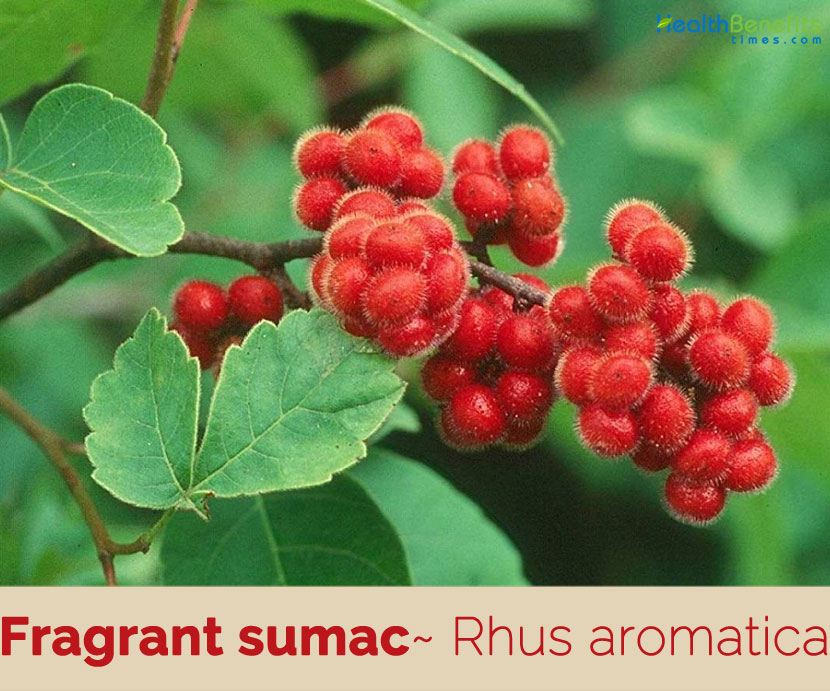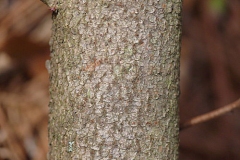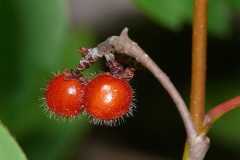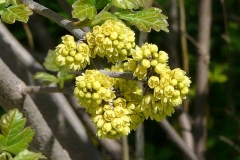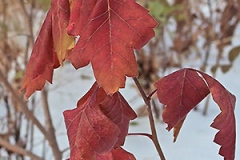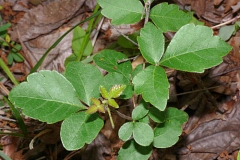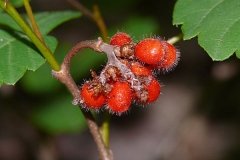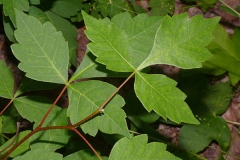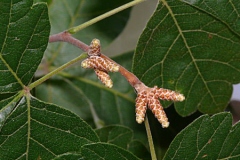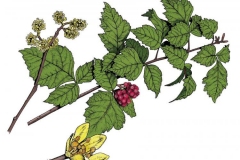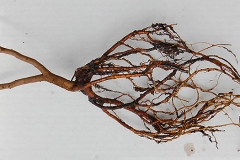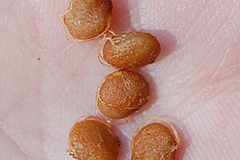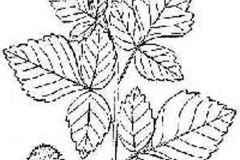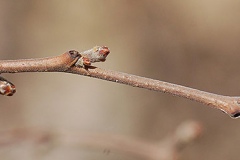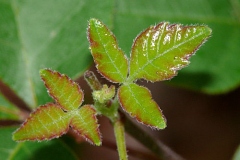While this species is not really well-known and used often by landscapers and homeowners, the cultivar ‘Gro-low’ is commonly planted as a high groundcover, and some are sold at most any nursery or garden center. However, buying this plant is done mostly by landscape architects and designers, (or by customers influenced by nursery personnel recommending it), who know the plant, while most homeowners do not know it and look instead for bushes or groundcovers with pretty flowers or evergreen foliage. ‘Low-Gro’ sumac grows about 2 ft. high and easily spreads 6 to 8 ft. around, developing good autumn color.
Fragrant Sumac Facts
| Fragrant sumac Quick Facts | |
|---|---|
| Name: | Fragrant sumac |
| Scientific Name: | Rhus aromatica |
| Origin | North America |
| Colors | Red |
| Shapes | Hairy drupes, 0.2 to 0.3 inches (5 - 7 mm) in diameter |
| Taste | Astringent |
| Health benefits | Beneficial for colds, stomach aches, bleeding, diarrhea, dysentery, vaginal discharge, skin eruptions, toothaches, late-onset diabetes, mouth and throat complaints |
| Name | Fragrant Sumac |
|---|---|
| Scientific Name | Rhus aromatica |
| Native | North America |
| Common Names | Fragrant sumac, Skunk bush, Stink bush, Sweet sumach, Aromatic sumac, Lemon sumac, Polecatbush, Squawbush, Sweet sumac, squawbush, sweet-scented sumac, winged Sumac, smooth Sumac, staghorn Sumac |
| Name in Other Languages | Arabic: Simaq eatariun (سماق عطري) Armenian: Aghtor buravet (Աղտոր բուրավետ) Danish: Duft-Sumak Dutch: Welriekende sumak English: Fragrant sumac, Skunk bush, Stink bush, Sweet sumach, Aromatic sumac, Lemon sumac, Polecatbush, Squawbush, Sweet sumac, squawbush, sweet-scented sumac, winged Sumac, smooth Sumac, staghorn Sumac Finnish: Tuoksusumakki French: Sumac aromatique, Sumac odorant German: Duftender Sumach, Gewürzsumach, süsser Sumach Navajo: Chiiłchin Russian: Sumakh aromatnyy (Сумах ароматный), Sumakh dushistyy (Сумах душистый) Swedish: Doftsumak |
| Plant Growth Habit | Straggling to upright deciduous woody shrub, rarely becoming more tree-like |
| Growing Climates | Dry rocks, sands, open woods, often on limestone outcrops, disturbed sites, fencerows, roadsides, abandoned fields, forest, grassland borders, glades, bluff tops, savannas, openings in upland forests, old fields, railroads, open rocky woodlands, valley bottoms, lower rocky slopes, wooded bluffs, upland rocky woods, barren rocky areas, limestone glades and sand prairies |
| Soil | Tolerate a variety of soil types, but is especially well adapted to shallow, infertile, rocky soils, derived from a variety of substrates: dolomite, limestone, sandstone, and chert. Sites are typically dry and excessively drained, and are commonly located on sandstone or shale ridges |
| Plant Size | 2-6 ft. (0.6-1.8 m) high with a spread of 6-10 ft. (1.8-3 m) |
| Root | Extensive, shallow root system |
| Bark | Dark, rusty-brown color externally, and a pink or walnut color below the cork. It is about ⅛ of an inch in thickness |
| Twigs | Slender, brown, finely fuzzy, buds small and yellowish brown surrounded by a circular leaf scars |
| Leaf | Fragrant when bruised, deciduous and alternate with 3 leaflets that are variable in shape, lobing, and margin. Mature leaflets are usually coarsely-toothed; terminal leaflets are 1.8 to 2.6 inches long (3-6.5 cm). |
| Flowering season | March-May |
| Flower | Individual flowers are inconspicuous and produced in showy, dense clusters or spikes, 0.7 to 2.5 inches (2-8 cm) long. |
| Fruit Shape & Size | hairy drupes, 0.2 to 0.3 inches (5 – 7 mm) in diameter, each containing a single seed |
| Fruit Color | Red |
| Seed | Single smooth reddish-brown oval to bean shaped nutlet |
| Propagation | By seeds and by sprouting and layering |
| Taste | Astringent |
| Plant Parts Used | Root bark, fruit |
| Season | June-August |
Plant Description
Fragrant sumac is a straggling to upright deciduous woody shrub, rarely becoming more trees that normally grows about 2-6 ft. (0.6-1.8 m) tall with a spread of 6-10 ft. (1.8-3 m). The plant is found growing in dry rocks, sands, open woods, often on limestone outcrops, disturbed sites, fence rows, roadsides, abandoned fields, forest, grassland borders, glades, bluff tops, savannas, openings in upland forests, old fields, railroads, open rocky woodlands, valley bottoms, lower rocky slopes, wooded bluffs, upland rocky woods, barren rocky areas, limestone glades and sand prairies. The plant tolerates a variety of soil types, but is especially well adapted to shallow, infertile, rocky soils, derived from a variety of substrates: dolomite, limestone, sandstone, and chert. Sites are typically dry and excessively drained, and are commonly located on sandstone or shale ridges. The plant has extensive, shallow root system.
Bark
The bark is of a dark, rusty-brown color externally, and a pink or walnut color below the cork. It is about ⅛ of an inch in thickness, and throughout the inner bark of a prime article are little cavities containing a transparent balsam, somewhat resembling balsam of fir. Wood is white or yellowish. When fresh, the wounded bark exudes a turpentine-like balsam, or solution of a resin in some volatile oil, which dries to a glossy tear or layer. The bark is astringent, but, undoubtedly, the turpentine-like balsam likewise possesses considerable medicinal value.
Leaves
The alternate leaves are trifoliate. The individual leaflets are up to 3 inches long and 1½ inches across, although they are often half this size. Terminal leaflet is somewhat larger than the lateral leaflets. They are elliptic, oval-ovate, oblanceolate, or obovate in shape, coarsely crenate or shallowly cleft along their margins, and green, yellowish green, or red. The upper surface of each leaflet is glabrous to finely pubescent (canescent), while the lower surface is sparsely pubescent to softly hairy. Each leaflet is sessile, or it has a short petiole. The crushed foliage has a pleasant bittersweet fragrance.
Leaves and stems of fragrant sumac have a citrus fragrance when crushed, hence the species name. Leaves resemble those of its relative poison ivy, but fragrant sumac is not poisonous. It inhabits mostly uplands areas, while poison ivy has no odor and can inhabit various habitats. It develops a good autumn color like other sumacs of bright yellow to red to red-purple. Some are grown by large, diverse nurseries or by native-plant nurseries and are infrequently planted in landscapes in the Midwest and East.
Flowers
Fruit
The blooming period occurs during the spring. During the summer, the flowers are replaced by hairy red drupes, about the size of a pea, covered with dense, white pubescence. They are produced in clusters of about a dozen, and are on stalks about ½ inches long. Each drupe is up to ¼ inches across and globoid-ovoid in shape. Fruit consists of a single smooth reddish-brown oval to bean shaped nutlet. These fruits provide winter food for Wild Turkey, grouse, wintering birds, and active small mammals. The foliage is not very palatable for most animals.
Traditional uses and benefits of Fragrant Sumac
- Leaves and root bark are astringent and diuretic.
- They were used in the treatment of colds, stomach aches and bleeding.
- An infusion can be used in the treatment of diarrhea, dysentery.
- It is used externally, it is used to treat excessive vaginal discharge and skin eruptions and also as a gargle for sore throats.
- Its use is contraindicated if inflammation is present.
- They have been chewed in the treatment of stomach aches, toothaches and gripe and used as a gargle to treat mouth and throat complaints.
- They help reduce fevers and may be of help in treating late-onset diabetes.
- Fruits and leaves are reported to have a variety of herbal pharmacological uses: analgesic, antidiarrheal, burn dressing, cold remedy, dietary aid, diuretic, toothache remedy, reproduction aid, and gynecological aid.
- Native Americans used it for a variety of medicinal purposes such as to control vomiting and fever, treat scurvy, and as a poultice for skin ailments.
- Tart fruits have been chewed as a breath freshener.
Culinary Uses
- Fruit can be consumed raw or cooked.
- Fruit is small with very little flesh, but it is easily harvested and when soaked for 10 – 30 minutes in hot or cold water makes a very refreshing lemonade-like drink (without any fizz of course).
- The mixture should not be boiled since this will release tannic acids and make the drink astringent.
- The fruit can also be dried and ground into a powder then mixed with corn meal and used in cakes, porridges etc.
- American Indians made a tart drink from the ripe fruits of fragrant sumac.
- Ripe fruits are dried and used in teas.
Other Uses
- Leaves are rich in tannin (up to 25%) and can be collected as they fall in the autumn then used as a brown dye or as a mordant.
- Bark is also a good source of tannin.
- Oil is extracted from the seeds.
- It attains a tallow-like consistency on standing and is used to make candles.
- These burn brilliantly, though they emit a pungent smoke.
- The plant has an extensive root system and is sometimes planted to prevent soil erosion.
- The split stems are used in basket making.
- It grows at about 12 to 18 inches per year.
- The leaves, mixed with tobacco, were used as a smoking mixture.
Precautions
- There are some suggestions that the sap of this species can cause a skin rash in vulnerable people.
- Avoid its use during pregnancy and breast feeding.
References:
https://www.itis.gov/servlet/SingleRpt/SingleRpt?search_topic=TSN&search_value=28779#null
https://npgsweb.ars-grin.gov/gringlobal/taxonomydetail.aspx?id=101781
https://pfaf.org/user/plant.aspx?LatinName=Rhus+aromatica
https://www.missouribotanicalgarden.org/PlantFinder/PlantFinderDetails.aspx?kempercode=l980
https://plants.usda.gov/core/profile?symbol=RHAR4
https://www.fs.fed.us/database/feis/plants/shrub/rhuaro/all.html
https://en.wikipedia.org/wiki/Rhus_aromatica
http://tn-grin.nat.tn/gringlobal/taxonomydetail.aspx?id=101780
https://gd.eppo.int/taxon/RHUAR
http://www.theplantlist.org/tpl1.1/record/tro-50130206
https://plants.usda.gov/plantguide/pdf/cs_rhar4.pdf
https://www.illinoiswildflowers.info/savanna/plants/fragrant_sumac.htm


